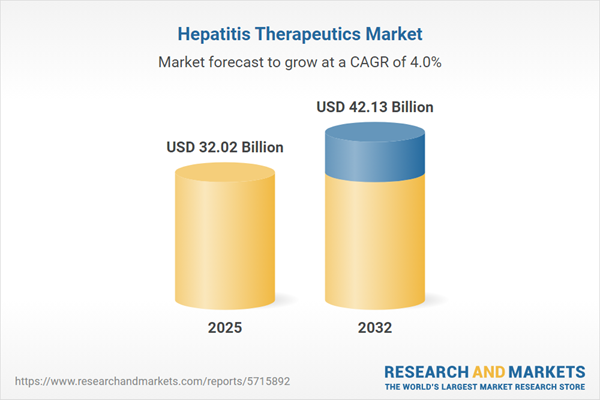Speak directly to the analyst to clarify any post sales queries you may have.
The hepatitis therapeutics market is undergoing accelerated transformation. Senior leaders now emphasize adaptable strategies, digital innovation, and cross-sector partnerships to address evolving regulatory and clinical demands while sustaining growth in a competitive climate.
Market Snapshot: Hepatitis Therapeutics Market Trends
The hepatitis therapeutics market demonstrates strong upward momentum, driven by continuous investment and increasing competitive intensity. Companies are shortening innovation cycles, introducing advanced therapies designed to improve patient outcomes and streamline operational processes. Evolving regulatory requirements and shifting payer priorities are prompting organizations to upgrade digital engagement and refine supply chains. This shift encourages a broader adoption of patient-focused care models and enables faster clinical advancements. Regional differences further influence operating conditions, making it vital for market participants to adjust their strategies to build resilience against diverse commercial and compliance pressures.
Scope & Segmentation: Strategic Overview of the Value Chain
This report provides a focused breakdown for senior executives, supporting effective resource allocation and market positioning across the hepatitis therapeutics landscape:
- Therapeutic Class: Combination regimens, direct acting antivirals, NS3/4A protease inhibitors, NS5A inhibitors, NS5B polymerase inhibitors, pan-genotypic agents, interferons, and nucleotide analogues, each offering a platform for innovation and portfolio flexibility.
- Genotype: Comprehensive coverage across all hepatitis genotypes, enabling deeper segmentation and the advancement of personalized care driven by genetic and biomarker analysis.
- Route of Administration: Assessment of injectable and oral therapies, influencing adherence, scalability, and delivery models in different care settings.
- Distribution Channel: Analysis of hospital, retail, and online pharmacy networks, each shaping access strategies and market outcomes.
- Stage of Disease: Coverage of acute and chronic hepatitis, supporting tailored pathways that address the full range of patient needs.
- Regions: Evaluation of market dynamics in the Americas, Europe, Middle East, Africa, and Asia-Pacific, highlighting local context and global integration.
- Companies Analyzed: Benchmarking of key industry players including Gilead Sciences, AbbVie, Merck & Co., Bristol-Myers Squibb, Johnson & Johnson, F. Hoffmann-La Roche, Novartis, Pfizer, GlaxoSmithKline, and Sanofi.
Key Takeaways: Strategic Insights for B2B Leaders
- Direct acting antivirals and combination therapies are facilitating coordinated care among providers, delivering more consistent outcomes and heightened operational efficiency in principal segments.
- A diverse range of multi-mechanism and pan-genotypic agents enables engagement with varied patient groups and strengthens organizational agility in response to clinical shifts.
- Collaboration with academic and digital health partners is streamlining discovery and development, empowering companies with improved, data-driven decision support.
- The emergence of biosimilars and generics, together with evolving reimbursement models, is transforming access approaches, intensifying competition, and bolstering supply chain strength across the sector.
- Responding to regulatory complexity, particularly in Asia-Pacific, now requires sophisticated planning and ongoing adaptation to navigate emerging compliance frameworks.
- Strategically expanding regional manufacturing and adopting flexible licensing remain critical for ensuring operational continuity and mitigating disruptions.
Tariff Impact: U.S. Tariff Adjustments Reshaping Supply Chains
Recent U.S. tariff changes have driven organizations to strengthen domestic sourcing and diversify supplier networks, diminishing logistics risks and promoting price stability within hepatitis therapeutics supply chains. These developments heighten the importance of contract manufacturing as companies pursue cost efficiencies and operational reliability. Flexible formulary management also plays a crucial role in maintaining patient access in an evolving regulatory environment, promoting continuity of care and commercial stability.
Methodology & Data Sources
This analysis is built on direct contributions from clinicians, pharmaceutical executives, payers, regulatory personnel, and academic experts. Scenario modeling incorporates current financial disclosures, sector trends, and academic studies, providing a timely perspective on ongoing challenges and market dynamics.
Why This Report Matters
- Supports executive teams in realigning R&D, strategic partnerships, and go-to-market tactics during significant industry and regulatory transitions.
- Delivers actionable segmentation to facilitate scenario planning, targeted allocation of resources, and dynamic risk management across global geographies.
- Enables senior leaders to recognize emerging growth opportunities and adapt to rapid changes in the hepatitis therapeutics market environment.
Conclusion
Organizations that pursue forward-thinking planning and develop tactical agility through strategic partnerships are well positioned for sustained performance. Unified leadership around these imperatives promotes effective change management and enduring business growth.
Additional Product Information:
- Purchase of this report includes 1 year online access with quarterly updates.
- This report can be updated on request. Please contact our Customer Experience team using the Ask a Question widget on our website.
Table of Contents
3. Executive Summary
4. Market Overview
7. Cumulative Impact of Artificial Intelligence 2025
Companies Mentioned
The companies profiled in this Hepatitis Therapeutics market report include:- Gilead Sciences, Inc.
- AbbVie Inc.
- Merck & Co., Inc.
- Bristol-Myers Squibb Company
- Johnson & Johnson
- F. Hoffmann-La Roche Ltd
- Novartis AG
- Pfizer Inc.
- GlaxoSmithKline plc
- Sanofi S.A.
Table Information
| Report Attribute | Details |
|---|---|
| No. of Pages | 199 |
| Published | October 2025 |
| Forecast Period | 2025 - 2032 |
| Estimated Market Value ( USD | $ 32.02 Billion |
| Forecasted Market Value ( USD | $ 42.13 Billion |
| Compound Annual Growth Rate | 4.0% |
| Regions Covered | Global |
| No. of Companies Mentioned | 11 |









